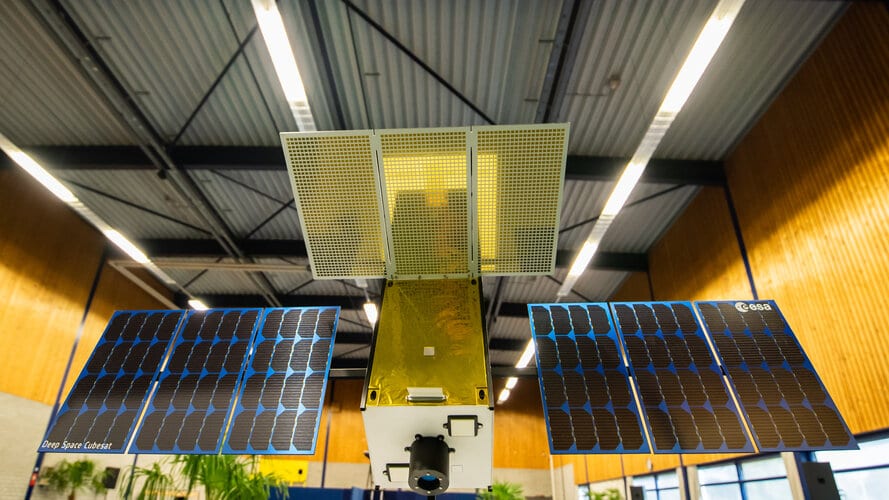
Image:
This replica model of ESA’s ‘Miniaturised Asteroid Remote Geophysical Observer’, or M-Argo, was on display at the Agency’s recent Antennas workshop . It is the one of numerous small missions planned as part of in ESA’s Technology Strategy , being presented at this month’s Space19+ Council at Ministerial Level.
This is a suitcase-sized nanospacecraft based on the CubeSat design employing standardised 10 cm cubic units within which electronic boards can be stacked and subsystems attached. M-Argo is a 12-unit CubeSat – with a 22 x 22 x 34 cm body – that would hitch a ride on the launch of a larger space mission whose trajectory takes it beyond Earth orbit, such as astronomy missions to a Sun–Earth Lagrange point.
The CubeSat would then use its own miniaturised electric thruster to take it into deep space and rendezvous with an asteroid, which it would survey using a multispectral camera and a laser altimeter to look for resources such as hydrated minerals that could be extracted in future. Other miniaturised payloads are also being considered.
“Such a small spacecraft has never independently travelled through deep space to rendezvous with an asteroid before,” comments Roger Walker, overseeing ESA’s Technology Cubesats . “It will enable the cost of asteroid exploration to be reduced by an order of magnitude or more.”
Numerous miniaturised technologies are currently being developed to enable the M-Argo mission, including the electric propulsion system, a high frequency ‘X-band’ communications system with a flat panel antenna – as seen in the image – to communicate with Earth at distances of up to 150 million km and a mechanism to steer the solar panels constantly at the Sun to generate enough power for the electric propulsion and communications systems.
The M-Argo CubeSat and its mission are currently being designed for ESA by a team consisting of Gomspace in Luxembourg and Politecnico di Milano in Italy.
“The team has identified a total of 148 near-Earth asteroids potentially reachable for a rendezvous using design,” adds Roger. “From these, five different asteroids have been carefully selected for further analysis in terms of optimising their rendezvous trajectories and close-up navigation – some of the closest to Earth in terms of the amount of fuel needed to get there: a key consideration for future mining of in-situ resources.
“M-Argo design has recently reached a milestone with the Mission Definition Review, which confirms that the CubeSat can rendezvous with any one of these five different asteroids, if launched during the 2023-2025 timeframe. The M-Argo team will now focus on completing the design concept of the CubeSat up until April next year. ”
“This is the first time ESA is designing a low-cost spacecraft for asteroid mining purposes in line with the Luxembourg space strategy . M-Argo and numerous other innovative technology-testing CubeSat missions, are being supported through the Fly element of the Agency’s General Support Technology Programme , part of ESA’s Technology Strategy being presented at Space19+.” says Kenza Benamar, Coordinator of the Fly element.
Also being presented at the Ministerial is the Hera asteroid mission, a larger-scale spacecraft that would deploy two CubeSats when it reaches its target binary asteroid system.
Comments are closed.